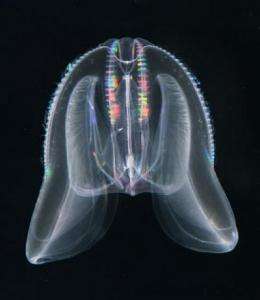Voracious comb jellyfish 'invisible' to prey

Despite its primitive structure, the North American comb jellyfish can sneak up on its prey like a high-tech stealth submarine, making it a successful predator. Researchers, including one from the University of Gothenburg, have now been able to show how the jellyfish makes itself hydrodynamically 'invisible'.
The North American comb jellyfish Mnemiopsis leidyi has long been known to consume vast quantities of zooplankton. A few years ago the species became established in Northern Europe.
Like many other jellyfish, Mnemiopsis leidyi has a large gelatinous body. The large size increases its chances of encountering prey, but can also be a disadvantage since the prey organisms are often highly sensitive to movements in the water. Nevertheless, the comb jellyfish manages to catch large amounts of copepod plankton, which are known for their acute escape response.
'Copepods have a well developed ability to detect even the slightest water disturbance,' says Lars Johan Hansson, a researcher at the Department of Marine Ecology at the University of Gothenburg. 'They can swim well clear of the source of water deformation in just a split second. How the comb jellyfish is able to approach and catch some of the animal world's most vigilant plankton has up until now been unknown.'
The researchers used advanced video technology to study water flows around and within the comb jellyfish. These measurements were then used to calculate the water deformation generated by the jellyfish and compare this with the levels that trigger an escape response in copepods.
'It emerged that the comb jellyfish uses microscopic, hairlike cilia inside its oral lobes to generate a feeding current that carefully transports water between the lobes. As the water accelerates slowly and is transported undisturbed into the jellyfish together with the prey, there is nothing that alarms the prey until it is next to the capture site inside the lobes, by which time it's too late to escape. This makes the jellyfish a hydrodynamically silent predator.'
More information: The study – Stealth predation and the predatory success of the invasive ctenophore Mnemiopsis leidyi – has been published in the scientific journal PNAS.
Provided by University of Gothenburg















